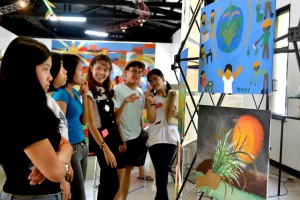Science City of Muñoz, Nueva Ecija – Most of the participants in the Rice Science and Art Summer Camp, conducted on 19-22 May at PhilRice in Nueva Ecija had resolved to consider working in the agriculture sector after completing their studies. 
“As city dwellers, we are unaware of the processes that the rice undergoes before it reaches our plates. This camp made me realized the intricacies of rice production and the importance of not wasting a rice grain,” Rica Paula Dianne Capistrano of Manila Science High School said.
“As agriculture is indispensable in maintaining our own food supply, I am thinking of taking a career in this field as a researcher,” she added.
Organized by the Rice Science Museum, the camp aimed to engage the urban youth in agriculture through lectures on rice and health, its journey, and culture; field exposure; and the arts.
Using impressionism, Capistrano drew the Rice Planters based on camp activities such as tour in the gene bank, where more than 10,000 rice accessions are stored; Future Rice, an ideal farm set-up that can be replicated by farmers; and the gene pool of the Philippine Carabao Center.
Her artwork shows the colorful struggles that farmers experience to sustain the connection among the tillers, rice, and the consumers.
“Farmers are good inspiration, because they are not whiners and do not easily give up on their work no matter what,” the 16-year-old who represented other participants from the F. Ma. Guerrero Elementary School and Margarita Roxas de Ayala said.
Charisma Love B. Gado, senior science research specialist, said that youth commitment in agriculture is crucial for development.
“The future of food security depends on the anticipated participation of youth in agriculture, not necessarily as farmers, but as investors, agri professionals, or advocates. However, a disinterest and indifference in agriculture could be observed among them; so, we explored the arts as a more interesting way to educate them on rice science,” the activity organizer said.
The participants’ appreciation of rice and understanding of its science were expressed in about 20 artworks, which will be launched in July. Some of these works are titled, Play of Nature, Moonlight, Abundance, Capture, Field, and Ignorance.
Career opportunities in agriculture were also presented to the students. According to Gado, agriculture is a diverse field of research and development, business, and instruction. Travel and career growth opportunities are also available through national and international scholarships.
“Agriculture has been the main driver of progress in societies and if we may recall, its discovery led to the organization of peoples and to the structuring of communities. We hope that the value on how agriculture had changed us will remain important to the modern youth and their generations,” she said.




